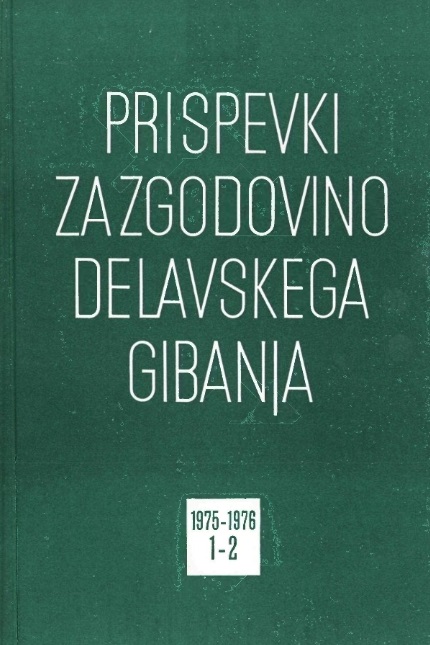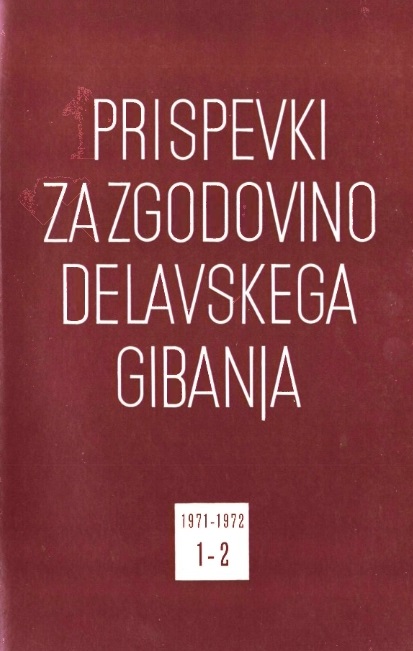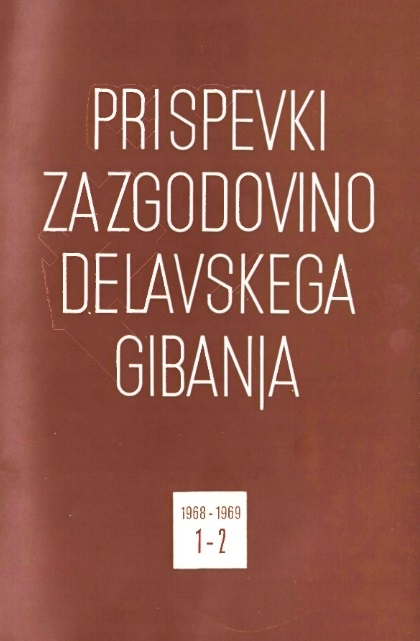
Recenzija: Slovenci v zamejstvu — Pregled zgodovine 1918—1945
The review of: Tone Ferenc, Milica Kacin-Wohinz, Tone Zorn: Slovenci v zamejstvu — Pregled zgodovine 1918—1945, Državna založba Slovenije, Ljubljana 1974; strani 326.
More...We kindly inform you that, as long as the subject affiliation of our 300.000+ articles is in progress, you might get unsufficient or no results on your third level or second level search. In this case, please broaden your search criteria.

The review of: Tone Ferenc, Milica Kacin-Wohinz, Tone Zorn: Slovenci v zamejstvu — Pregled zgodovine 1918—1945, Državna založba Slovenije, Ljubljana 1974; strani 326.
More...
The review of: Rudolf G. Ardelt, Zwischen Demokratie und Faschismus. Deutschnationales Gendankengut in Österreich 1919—1930. Wien-Salzburg 1972; strani 212 + XVI bibliografije.
More...
The review of: - Hans-Adolf Jacobsen, Nationalsozialistische Aussenpolitik 1933—1938. Alfred Metzner Verlag, Frankfurt/M.—Berlin 1968; strani 944. - Horst Rohde, Das deutsche Wehrmachttransportwesen im Zweiten Weltkrieg. Entstehung — Organisation — Aufgaben. Deutsche Verlags-Anstalt, Stuttgart 1971; 439 strani.
More...
The review of: Anton Ožbolt, Dežela Petra Klepca. Založba Borec, Ljubljana, 1974; strani 577 + III.
More...
The review of: Slavko Kremenšek, Slovensko študentovsko gibanje 1919—1941, Lj., Mladinska knjiga 1972.
More...
The review of: Lavo Čermelj, Med prvim in drugim tržaškim procesom. Slovenska matica, Ljubljana 1972 — 241 strani, 11 slik, 2 faksimila
More...
The review of: Hildebrand Klaus, Deutsche Aussenpolitik 1933—1945. Kalkül oder Dogma? Verlag W. Kohlhammer GmbH, Stuttgart—Berlin—Koln—Mainz, 1971. 186 strani
More...
The point of departure of this action are the activities' of the Communist Party of Yugoslavia and its youth organization SKOJ to gain influence among the Slovene youth and to realize the demands of the youth.
More...
Ozbiljno stanje u zemlji izazvano nacionalnim ugnjetavanjem Hrvata, Slovenaca, Makedonaca i drugih naroda od strane velikosrpske buržoazije uslovilo je interes za nacionalno pitanje u slovenačkom radničkom pokretu. Preispitivanju opšteprihvaćenog stanovišta u radničkom pokretu Jugoslavije da je nacionalno pitanje isključivo problem buržoazije u toku 1922. i prvoj polovini 1923. znatno su doprinjeli predstavnici radničkog pokreta-iz Slovenije. Preispitivanjem i obaranjem ovoga stanovištva legalno je odbacivan-negatorski odnos KPJ prema nacionalnom pitanju. U vezi sa ovim predstavnici slovenačkog radničkog pokreta znatno su doprinjeli interesovanju 2. zemaljske konferencije KPJ, maja 1923, za nacionalno pitanje kao i donošenju njene odluke da se u NRPJ povede jedna šira diskusija o nacionalnom pitanju u Jugoslaviji. [...]
More...
V gradivu o izgonih tujih 'državljanov iz Jugoslavije, ki ga hrani Arhiv Slovenije (tehnični fascikel 13—21), je shranjena za leto 1925 zanimiva dokumentacija o poskusu izgona znanih slovenskih komunističnih delavcev, bratov Zorga v Italijo, v domnevi, da sta italijanska državljana in po mnenju ljubljanske policijske oblasti pristojna v takratno občino Slavina (okraj Postojna). V tem okviru je skušala Ljubljana konec leta 1924 tudi doseči priznanje od italijanskih oblasti, vendar zadevna intervencija jugoslovanskega konzulata v Trstu ni rodila sadu. Zanimivo je, da dokumentacija utemeljuje potrebo po izgonu obeh bratov z njuno komunistično dejavnostjo. Dokumentacija tudi kaže, da sta brata vložila pri pristojnih oblasteh prošnjo za priznanje jugoslovanskega državljanstva, »vendar njihova (pač njuna — op. T. Z.) opcija ni bila sprejeta ravno radi njihovega komunističnega udestvovanja« (dopis velikega župana ljubljanske oblasti ministrstvu za notranje zadeve, oddelek za Slovenijo, Beograd. Množinska oblika v dopisu se nanaša še na Ivana Makuca kateremu so italijanske oblasti priznale tamkajšnje državljanstvo). [...]
More...
»Razpravo« Jožeta Pahorja Iz boja slovenskega učiteljstva za neodvisnost — hrani jo arhiv Inštituta za zgodovino delavskega gibanja — objavljamo brez uvoda (približno desetine besedila), to je brez orisa razmer, v katerih je učiteljski stan delal zadnja leta Avstro-Ogrske, in brez odstavkov o slovenskem učiteljstvu v prvih letih Jugoslavije in pod Italijo. Vse to namreč Pahor sam natančneje osvetljuje v razpravi Učiteljstvo v Slovenskem .primorju in Istri v letih 1906—1926 (Zbornik založbe Lipa Koper, 1956). Pahor imenuje svoj prispevek »razprava«, čepraj} ni navedel virov, na katere se opira, in je črpal marsikaj očitno iz lastnih spominov. Opombe pod črto je dodal njegov prijatelj in poznavalec zgodovine slovenskih učiteljev iz izkušenj prof. Venčeslav Čopič, vmesne naslove pa je vpisal na željo uredništva Janko Liška, ki je besedilo tudi lektoriral in s pomočjo prof. Čopiča izoblikoval nekaj vsebinsko oziroma stilistično nedodelanih mest. Pahorjev prispevek, ki govori predvsem o »deklardcijskem « gibanju med slovenskim učiteljstvom v Jugoslaviji v drugi polovici dvajsetih let, objavljamo zaradi vsebinske pomembnosti in verodostojnosti (saj je bil Pahor eden od voditeljev omenjenega gibanja) pa tudi v spomin na dolgoletnega požrtvovalnega borca za narodne, splošne socialne in posebej za učiteljske stanovske pravice. [...]
More...
Pregled tiskanih virov in literature o koroškem vprašanju od znanega plebiscita 10. oktobra 1920 pa do napada na Jugoslavijo leta 1941 si podobno kot pregled za koroško plebiscitno obdobje, ki je izšel v zborniku Koroški plebiscit, Ljubljana 1970, ne lasti popolnosti, ampak skuša v danih mejah zajeti dostopno tiskano gradivo in literaturo. Vendar pa so med obema bibliografijama nekatere razlike, saj je sam značaj literature vodil k nekaterim odstopanjem od bibliografije, podane v delu Koroški plebiscit. [...]
More...
»Labinski republiki« in sočasnemu proštanskemu kmečkemu odporu je bilo posvečeno posvetovanje, ki ga je 2. in 3. marca 1971 v Rabcu organiziral Sjeverojadranski institut z Reke pod pokroviteljstvom hrvaške Jugoslavenske akademije znanosti i umijetnosti.
More...
The review of: Milorad Ašković, dr. Jerko Radmilović, Novica Petrovič, Savez bankarskih, osiguravajućih, trgovačkih i industrijskih činovnika Jugoslavije — BOTIČ — 1902—1941. Izdal Institut za savremenu istoriju, Beograd 1971, strani 576.
More...
The review of: Ob prispevku Štefana Kuharja k zgodovini gibanja kmetske mladine v Sloveniji med dvema vojnama
More...
Presentation of the development of the workers' cooperatives from the last decades of the 19th century until the beginning of the World War II.
More...
V referatu želim osvetliti dosedanje objave virov, opozoriti na delovne programe nekaterih institucij glede izdajanja gradiva za slovensko zgodovino za obdobje med vojnama, poskušal pa bom dati tudi nekaj pobud za nadaljnje delo na tem področju. Kritična analiza dosedanjih izdaj virov naj bi bila hkrati tudi delen odgovor na vprašanje, kako bi bilo treba vire objavljati, da bi bili za zgodovinarja čimbolj uporabni. Poudariti pa moram, da bo moj odgovor na vprašanje, kaj bi bilo v prihodnje koristno objavljati, zaradi zapletene problematike virov za obdobje od 1918 do 1941 lahko le skromen prispevek k današnji razpravi in naslednjim v krogih raziskovalcev in arhivarjev o tej problematiki. [...]
More...
Pod tem naslovom je 25. in 26. septembra 1969 v organizaciji Muzeja Avnoja in Pounja v Bihaču potekalo zborovanje zgodovinarjev predvojnega gibanja jugoslovanske mladine 'in' publicistov ter družbenopolitičnih delavcev iz vseh jugoslovanskih republik. Prisotna sta bila tudi gosta iz Italije in ČSSR.
More...
Diese Atohandlung zeigt die Entwiklung der Aribeitsschuitzgesetegebuing in Slowenien im Zeitoraume zwischen dem Ersten und den Zweiten Waltfcrieg; sie behandelt die Wirksamkeit und den Umfang der durohgefuhrten Arbeitsschutzgesetzgebung und anderer socialpoJitischer Massnahmen. Weiters zeigt die Abhandlung die Organisation, Eatwiklung und die Tatigkeit der Instituitionen des Arbeiterschutzes. Bis zum Eraten Weltfcrieg war in Slowenien die osterreichische Gesetzgebung in Kraft. Nach der Griindung des neuen Staates wurde die osterreichische, ungarische und serbische Gesetzgebung mit einer einheitlichen jugosdavvischen Gesetzgebung ersetzt. Das Arbeitsinspektionsgesetz erschien am 30. 12. 1921, das Arbeiterschutzgesetz am 28. 2. 1922 und das Arbeiterversichenmgsgesetz am 14. 5. 1922. Die Uinterstiitzung der Arbeitslosen und die ArbeitsvermittLung besorgte in Slowenien schen die Nationalregierung der SHS in Ljubljana mittels der Verordnung vom 5. 12. 1918, spater ubernahmen diese Aufgabe die offentliohen Arbeitsborsen. Die Geldmittel wurden durch Beitrage von den Arbeitslohnen gesammeJt. Bei der Entstehung Jugoslawiens wirkten nur drei Arbeitsinspetotionen: in Ljubljana, Sarajevo und Split. Bis zum Jahre 1921 waren es schon 12. Ihre Aufgabe war die richtige Ausfuhrung der Arbeitsschutgesetzgebung zu beaiufsiohtigen. Bei seiner Arbeit stiess dieser Dienst auf grosse Schwierigkeiten und Hindernisse, welche das Resultait von Klassengegensatzen im adten Jugoslawien waren.
More...
The review of: -Jeklo in ljudje. Jeseniški zbornik I. Kranj 1965, 552 strani. -Zbornik prispevkov iz zgodovine delavskega gibanja med vojnama in iz narodnoosvobodilnega boja na področju občine Ljubljana Moste—Polje. Ljubljana 1965. 357 strani.
More...